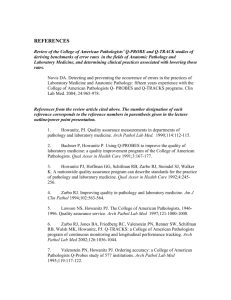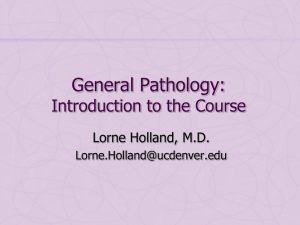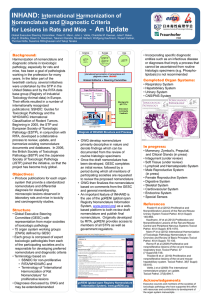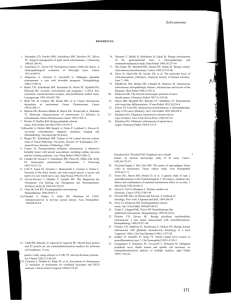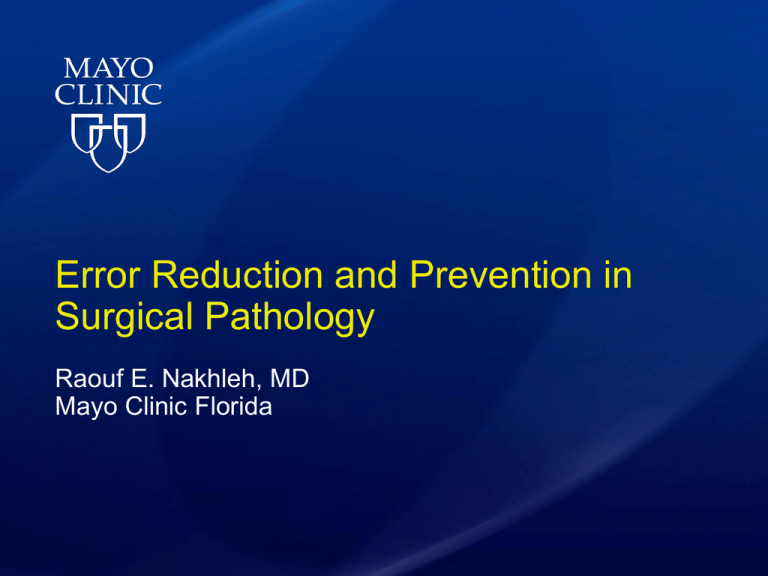
Error Reduction and Prevention in
Surgical Pathology
Raouf E. Nakhleh, MD
Mayo Clinic Florida
Disclosure
• None
2
Objectives
• At the end of the presentation participants
should be able to:
• Identify where errors occur within the test
cycle
• Implement effective methods to help detect
and prevent errors
• Apply general principles of error reduction to
enhance the overall quality of surgical
pathology
Agenda
•
•
•
•
Source, frequency and significance of errors
General principles of error reduction
Identification errors (pre-analytic)
Reasons for diagnostic (analytic) error
• Clinical history and clinical correlation
• Prospective and retrospective case reviews
• Post-analytic errors
• Report completeness
• Communication beyond the report
Error Rates
# of
Cases
Case
Selection
Error
Rate(%)
Sig. Error
Rate(%)
Safrin & Bark,
1993
5,397
Consecutive
0.5
0.26
Whitehead, 1985
3,000
Consecutive
7.8
0.96
Lind, 1995
2,694
Diagnostic Bx
13
1.2
Lind, 1995
480
Random
12
1.7
0.0 - 2.36
0.34 - 1.19
2.6
13.2
0.36
3.2
Renshaw, 2003
11,683
Raab, 2008
7,444
380
5% Random
Focused
Error Rates
Inter-institutional review
Error Rate (%)
Significant Error
Rate (%)
Kronz, 1999
N/A
1.4
Abt, 1995
7.8
5.8
1—30
2—5
Malhotra, 1996
11.6
N/A
Weir, 2001
6.8
3.7
Tsung, 2004
11.1
5.9
Gupta, 2000
Errors in Surgical Pathology
• Pre-analytic
• Wrong identification: 27-38%
• Defective specimens: 4-10%
• Analytic
• Diagnostic mis-interpretation: 2329%
• Post-analytic
• Defective report: 29-44%
• Am J Clin Pathol 2008;130:238-246
The Doctors Company
• Am J Surg Pathol 2004;28:1092-1095
• 272 surgical pathology claims (1998-2003)
• 166 (61%) false negative
• 73 (27%) false positive
Analytic
• 10 (4%) frozen section
• 22 (8%) operational
•
•
•
•
13 mix-ups
Pre-analytic
3 floaters
Analytic Post-analytic
2 mislabeled biopsy site
One transcription error, “no” omitted before
malignant cells
171 Jury Verdict and Settlements
• Arch Pathol Lab Med. 2007;131:615-618
• LexisNexis search
Surgical
Pathology
Cytology
Clinical
Pathology
1988-1993
26
9
16
1994-1999
25
20
14
2000-2005
33
19
9
Total
84 (49%)
48 (28%)
39 (23%)
Surgical Pathology Cases
• False negative, 73%
Analytic
• False positive, 19%
• System errors, 8%
Pre-analytic
• 4 lost or mixed-up specimens
• 2 floaters lead to false positive
• 1 no communication of lack of chorionic
villi in POC leading to ruptured tube
Post-analytic
Risk
• Pre-analytic
Specimen identification
• Clinical information
•
• Analytic
•
Diagnostic accuracy
• Post-analytic
Report completeness
• Communication of significant results
•
Factors That Lead to Errors
• Hand-offs
• Weak links
• Complexity
• Risk of error increases with every
step
• Inconsistency
• Level of training, performance,
procedures, communication,
language or taxonomy
Factors That Lead to Errors
• Human intervention
• Machines are better at routine tasks
• Humans are better in unexpected
conditions
• Time constraints
• Forces compromise
• Inflexible hierarchical culture
Error Reduction
• Sustained error reduction generally
comes with a comprehensive persistent
effort
• Unlikely to succeed with one intervention
• Continuously examine and redesign
systems
• Build-in prevention and detection systems
Error Reduction
• Build-in QA and QC monitors
• Continuously monitor and analyze QA and
QC data
• Intervene at the earliest sign of variations
• Share quality assurance data
• Communicate to all workers that their work
matters to patients
Error Reduction in Anatomic Pathology
• Standardize all procedures
• Remove distractions
• Accessioning, grossing, cutting,
microscope, sign-out
• Make people aware of this potential
• Automate where possible
• Specimen handling, analyzers
• Comprehensive computer systems
Error Reduction in Anatomic Pathology
• Remove inconsistent tools
• Handwriting
• Reduce complexity
• Automation
• Lean design
• Make everyone aware of hand-offs (problem
points)
• Reduce reliance on memory
• Checklists
Error Reduction in Anatomic Pathology
• Enhance communication
• Electronic medical record
• Computer physician order entry (CPOE)
• Adequate and appropriate staffing
• Batch work
• Redundancy
• Suitability
• Adequate and appropriate facilities
• Space, lighting
• Reduce the stress level
Pre-analytic Errors
• Specimen identification
• Specimen information
• Handling problems
• Fixation
Specimen Identification
• Reasons for ID errors
• Dependent of numerous individuals
and locations outside the control of
the laboratory
• Inconsistent training
• Inconsistent application of labeling
standards
Specimen Identification
• CAP study of 1 million surgical
specimens in 417 Laboratories
• 6% deficiencies (Median 3.4%)
• Specimen ID problems 9.6%
• Information problems 77%
• Handling problems
3.6%
• Others
9.7%
Arch Pathol Lab Med 1996;120:227
Root Cause Analysis of VA Laboratories
• 227 Root Cause Analysis Reports
• ID errors accounted for 182/253 adverse events
• 132 (73%) pre-analytic, 37 (20%) analytic, 13 (7%) postanalytic
• Mislabeling associated with “batching” (35)
• Manual entry of lab forms (14)
• Failure of 2 person verification in blood bank (20)
• 27/37 analytic relabeling of containers-blocksspecimens
Specimen Identification
• Joint Commission patient safety goal
• Improve the accuracy of patient identification
• CAP patient safety goal
• Improve patient and sample identification
• Mishaps have led to disastrous examples of wrong
surgery or treatment
Specimen Identification
• PSG provide the muscle to be able to
attack this problem
• Need to adopt specimen identification
as an institutional goal (change the
culture)
• QA measure for clinics, OR, etc.
• Cannot be achieved from within the
laboratory
Specimen Identification
• Sustained awareness campaign
• Change the culture
―Extensive education and training with
annual refresher sessions
―Recent report of specimen time-out
• Strict adherence to labeling standards and
labeling procedures
• Remote order entry (forcing function)
• Newer technology may be helpful
• Make everyone in the process aware of
pitfalls and the possibility of misidentified
specimens
Factors that Improve Performance
• Limit preprinting of labels (batch printing)
• Look for ID errors prior to release of results
(QC checks)
• Investigate patient ID when not on file
• Continuously monitor ID errors
• Check report vs. requisition
• Use strict acceptance (rejection) criteria
• Arch Pathol Lab Med 2006;130:1106-1113
Improvement in Patient Identification
• 1 year, 0.8%
• 2 years, 2.7%
• 3 years, 3.8%
• 4 years, 4.1%
• 5 years, 5.6%
• 6 years, 6.2%
• Arch Pathol Lab Med 2003;126:809-815
Specimen ID
• Surgical specimen identification error: A new measure of quality in
surgical care. Surgery 2007;141:450-5
• Dept of Surgery, John Hopkins
•
•
•
•
•
•
•
•
•
21,351 surgical specimens
91 surgical specimen (4.3/1000) ID errors
18 not labeled
16 empty containers
16 laterality incorrect
14 incorrect tissue site
11 incorrect patient
9 no patient name
7 no tissue site
• 0.512% outpatient clinic, 0.346% operating rooms
Gross Room and Histology Lab
• Significant opportunity for error
• 2009 Q-Probes study in 136 labs
• 1.1/1000 mislabeled cases
• 1.0/1000 mislabeled specimens
• 1.7/1000 mislabeled blocks
• 1.1/1000 mislabeled slides
Gross Room and Histology Lab
• Error frequency
• Before and at accessioning 33.3 %
• Block labeling and dissection 31.9 %
• Tissue cutting and mounting 30.4%
• Errors detected at the one or two steps immediately
after the error
• Include periodic error checks throughout the system
Gross Room and Histology Lab –
Solutions
• Lean redesign
• Am J Clin Pathol 2009;131:468-477
• Reduce case ID errors 62%
• Reduce slide ID errors 95%
• Lean production – advantages
• Eliminates procedural steps (simplification)
• Aligns and even out workflow (eliminate batch
work)
• Judicial use of technology
• Barcodes, readers, labelers (consistency)
• Standardization of procedures (consistency)
Reasons for Diagnostic Error
• Lack or wrong clinical history
• Lack of clinical correlation
• Lack of training and experience
• Inappropriate and inconsistent application
of diagnostic criteria and terminology
• Human fallibility
• Time constraints
Error Factors
• Factors that correlated with error
•
•
•
•
•
Pathologist
Specimen type (breast, gyn >>GI, Skin)
Diagnosis (non-dx, atypia >>neg)
Sub-specialization
# of pathologist on report
• Factors not correlated with error
• Workload
• Years of experience
• Use of special stains
• Am J Clin Pathol 2007;127:144-152
Clinical History
• Clinical information in surgical pathology
• 771,475 case from 341 institutions
• 2.4% of cases have no history
• 5594 (0.73%) required additional information
• 31% resulted in a delay in diagnosis
• 6.1% of cases new information lead to substantial
change in diagnosis
Arch Pathol Lab Med 1999;123:615-619
Clinical History
• Study of amended reports
• 10% additional clinical history
• 20% clinician identifies
clinicopathologic discrepancy
• Arch Pathol Lab Med. 1998;122:303-309
• Malpractice Claims
• 20% failure to obtain all relevant
information
• Am J Surg Pathol 1993;17:75-80
Clinical History
• Affects diagnostic accuracy
• R/O tumor
• Medical disease
• Affects report completeness
• No published studies on attempts
to improve clinical history
Clinical History
• Solutions
• Electronic medical record
• Other IT solutions
Solutions
• Frozen section and final diagnosis
• Know the situation
• Look up case
• Ask questions
• Know your limitations
• Access to electronic medical record
helpful
• Choose your words wisely
• Get a second opinion when necessary
Standardized Diagnostic Criteria
• Breast borderline lesions
• Rosai Am J Surg Pathol 1991;15:209-21
• 17 proliferative lesions
• 5 pathologists with interest in breast disease
• Each used his/her criteria
• No agreement on any case by all 5
pathologists
• 33% diagnoses spanned hyperplasia to CIS
• Some pathologists consistently more benign
or more malignant
• High level of variability
Standardized Diagnostic Criteria
• Schnitt Am J Surg Pathol 1992;16:1133-43
• 24 proliferative lesions
• Six expert breast pathologists
• Used the same diagnostic criteria (Page)
• Complete agreement in 58% of cases
• Agreement of 5 or more in 71%
• Agreement of 4 or more in 92%
• No pathologists was more benign or malignant
than others
Standardized Diagnostic Criteria
• Use of standardized checklists
• Increases report completeness
• Everyone uses the same language
• Facilitates establishment and comparison of
treatment protocols
• Forces pathologists to update their knowledge
Redundancy (Review of Cases)
• Principle method used to prevent or detect
cognitive errors
• Most AP labs have limited # of specimens
for double read
• Breast, thyroid, pigmented skin lesions,
Barrett’s dysplasia, Brain tumors
• Taught early in training (instinctive)
• One method to keep up to date
• Problematic for small groups
Consultations
• 0.5% of all cases (median .7%, 0-2%)
• Arch Pathol lab med 2002;126:405-412
• Less in larger groups
• Presence of experts on staff
• ASCP guidelines
• Am J Clin Pathol 2000;114:329-335
• Problem prone case
• Defined by the individual, group,
clinician, patient or literature
Frequency of Routine Second Opinion
• Malignant diagnosis
• Breast CA on needle Bx
• Prostate CA on needle Bx
• Melanoma
• GI CA on biopsy
Unpublished data (2001) from PIP
program
42%
43%
58%
34%
Frequency of Routine Second Opinion
• Benign diagnosis
• Breast
• Prostate
• Nevi
6%
18%
8%
Unpublished data (2001) from PIP
program
Routine Review Before Sign-out
• CAP 2008 Q-Probes study
• Archives Pathol Lab Med 2010;134:740-743
• 45 Laboratories, 18,032 cases
• 6.6% (median 8.2%) had review before sign-out
• 78% reviewed by one additional pathologist.
• 46% for a difficult diagnosis
• 43% per departmental policy
Routine Review Before Sign-out
• 45% malignant neoplasm
• Most common organ systems
• GI 20%, breast 16%, skin 13%, GYN
10%
• Labs with review policy
• Higher review rates (9.6% vs. 6.5%)
• Reviewed a higher % of malignancies
(48% vs. 36%)
Routine Second Opinion
• 13% of case were seen by >1
pathologist
• Disagreement rate 4.8% vs. 6.9%,
P=.004
• Amended report rate 0.0 vs. 0.5%
• Best selection of case to be reviewed
remains unknown
Am J Clin Pathol 2006;125:737-739
Routine Second Opinion
• Comparison of rates of misdiagnoses over
two one year periods
• Without routine second review
• With routine second review
• Results
• 10 misdiagnoses without review out of
7909 cases (1.3%)
• 5 misdiagnoses with review out of 8469
cases (0.6%)
Pathology Case Review 2005;10:63-67
Routine Second Opinion
• Study of amended reports
• 1.7 million cases in 359 labs
• 1.6/1000 amended report reviewed after
sign-out
• 1.2/1000 amended reports reviewed before
sign-out
• Arch Pathol Lab Med. 1998;122:303-309
Pre-Sign out Quality Assurance Tool
• Am J Surg Pathol 2010;34:1319-1323
• Randomly selects an adjustable % of case for
review by a second pathologist
• Disagreements similar to retrospective reviews
• TAT slightly shorter (P=0.07)
• Amended reports decreased by 30%
• Amended reports for diagnostic edit decreased
55%
Method of Review (Renshaw and Gould)
• Tissue with highest amended rates: Breast 4.4%,
endocrine 4%, GYN 1.8%, cytology 1.3%
• Specimen types with highest amended rates:
Breast core bx 4.0%, Endometrial curettings
2.1%
• Diagnoses with highest amended rates: nondx
5%, atypical/suspicious 2.2%
• Am J Clin Pathol 2006;126:736-7.39
Method of Review (Renshaw and Gould)
• Reviewing nondiagnostic and atypical /suspicious
– review 4% of cases and detect 14% of
amended reports
• Reviewing all breast, GYN, non-GYN cytology
and endocrine material – review 26.9% of cases
and detected 88% of amended reports.
Method of Review (Raab et al)
• Targeted 5% random review vs. focused review
• 5% random review – 195/7444 cases (2.6%)
• Focused review 50/380 cases (13.2%)
• Thyroid gland (pilot), GI, bone and soft tissue,
GU
• P<.001
• Major errors: Random 27(0.36%) vs. Focused
12 (3.2%)
• Am J Clin Pathol 2008;130:905-912
Solutions
• Standardization
• Cancer checklists
• Terminology
• Redundancy
• Case reviews
• Multi-disciplinary teams and
conferences
• Clinical correlation
Post-Analytic Risk
• Complete reports
• Effective and timely communication of
important results
Post-analytic
• Complete reporting
• Evidence based medicine: oncology
• Commission on Cancer of the American
College of Surgeons
• Cancer Program Standards 2004
• 90% of cancer reports must have
required elements based on the
CAP’s publication Reporting on
Cancer Specimens
• Summary checklists
Post-analytic
• Branston et al. European J Cancer 38;764:2002
• Randomized controlled trial of computer
form-based reports
• 16 hospitals in Wales
• 1044 study , 998 control
• 28.4% increase in report completeness
• Acceptable by pathologist
• Preferred by clinicians
Critical Value Policies
• Based on regulatory mandates all
institutions have critical value policies
• Policies apply to clinical pathology,
radiology and other areas where testing is
done (cardiology, respiratory therapy, etc)
• Policies typically mandate that result is
reported within a specified timeframe
(usually 30 or 60 min)
• Clinical Labs report >95% within 30 min
62
Effective Communication of Important
Results
• Regulatory mandates
• CLIA 88
• immediately alert … an imminent life- threatening condition, or
panic or alert values
• Joint Commission
• develop written procedures for managing the critical results,
• define CR,
• by whom and to whom,
• acceptable time
• LAP
• There is a policy regarding the communication, and
documentation thereof, of significant and unexpected surgical
pathology findings
Surgical Pathology and Cytology
• Tissue processing takes hours and up to a day
to complete – Why 30-60 min to report?
• ?? Critical – most diagnoses are important for
treatment but not imminently life threatening
• Poor agreement among pathologists and
clinicians
• Most reported cases of patient harm related to
communication problems are due to lack of
communication or missed communication not
delay
64
Pereira et al AJCP 2008;130:731
• Do you believe that there are critical
values in:
• Surgical Pathology, 44/73 yes, 24 blank
• Cytology, 31/57 yes, 22 blank
• Surgical Pathology – Call ASAP
• Bacteria in heart or BM 91%
• Organism in immune compromised patient 85%
• Cytology – Call ASAP
• Bacteria or fungi in CSF 81% and 88%
© 2010 College of American Pathologists. All rights reserved.
65
Effective Communication of Important
Results
• Arch Pathol Lab Med 2009;133:1375
• 1130 Laboratories surveyed
• 75% had AP “Critical Diagnosis” policy
• 52% of those with policy listed specific
diagnoses
• Specific conditions included in the policy
• All malignancies 48.3%
• Life threatening infection 44.6%
66
Effective Communication of Important
Results
• Urgent diagnoses
• Imminently life threatening
• Very short list
• Reported quickly
• e.g. New infection in an immune compromised patient
• Significant unexpected diagnoses
• Not imminently life threatening
• Unusual or unexpected
• Difficult to anticipate
• Needs communication & documentation
• e. g. carcinoma in biopsy taken for medical disease
Summary
• Source, frequency and significance of errors
• General principles of error reduction
• Identification errors (pre-analytic)
• Reasons for diagnostic (analytic) error
• Clinical history and clinical correlation
• Prospective and retrospective case reviews
• Post-analytic errors
• Report completeness
• Communication beyond the report
68

